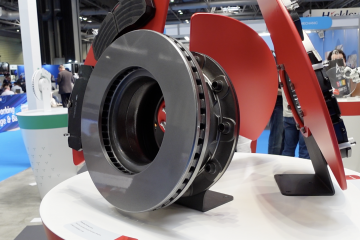The UK’s used-car market improved in the first quarter of the year, recording the strongest start since 2019.
Figures released by the SMMT show a total of 1,967,923 used car transactions between January and March 2024, a 6.5% rise on the same period last year. The increase marks the 16th consecutive month of growth, following the supply-chain crisis that impacted the new-car market.
Used car transactions increased in every month of the quarter, as supply continued to improve. January saw figures rise 5.1%, while numbers were up by 7.7% in February, and improved by 6.9% in March.
The increase in used car transactions is good news for the independent aftermarket, as it indicates that many buyers are looking for models free from the franchised dealer networks for their next vehicle. Many of the models sold would also have come from fleets renewing their stocks, highlighting the importance of fleet figures in new-car registrations.
As the UK’s car parc continues to age, with the majority of vehicles over 12-years-old, the increase in used car transactions suggests this trend will not slow soon. Garages can, therefore, expect an increase in opportunities for service and repair work, although training will be needed as newer technologies filter into the used car sector.
BEVs improve used car transactions
Despite performing well on the new-car market, where they led the UK to growth last month, electric vehicles are still lagging behind their more established petrol, diesel and hybrid counterparts when it comes to used car transactions.
First quarter sales of battery-electric vehicles (BEVs) increased by 71%, with 41,505 units changing hands. This gave the powertrain a record market share of 2.1%. While this may seem small, BEVs were the fastest-growing powertrain when it came to used car transactions. The technology can only be expected to improve further in the coming years.
BEVs currently have to contend with a limited supply into the used car market. Their popularity in the new car market only began after the COVID-19 pandemic, with limited numbers sold prior to that. With the average age of a car taking to the used car sector at around three years, it may be a little while until there is a larger supply of models available to second-hand seekers.
Many BEVs are also sold into the fleet sector, to help companies improve their green credentials. With 2020 and 2021 disrupted, and 2022 hit by the supply-chain crisis, smaller numbers of BEVs were sold. These figures increased in mid 2022, meaning it may not be until 2025 when BEV used car transactions improve.
However, private buyers, who paid a premium for their models, are likely to hold on to their vehicles for longer. As these vehicles age, the likelihood of seeking work from independent garages increases. Therefore, the number of BEVs entering the sector will rise in the coming years, with a potential boom in 2026 and beyond.
Petrol and diesel dominate
Predictably, it was internal-combustion engine (ICE) models that dominated used car transactions in the first quarter.
Sales of petrol models rose by 7.7% with 1,130,396 units changing hands in the three-month period. However, diesel transactions fell by 1.3%, with 697,718 sold. Combined, these cars accounted for 92.9% of all used car transactions, with this market share shrinking from 95.1% the year previously.
While the diesel number is down, this is not as big a drop as seen in the new car market. The latest UK car parc figures also show that 34% of cars on the country’s roads are diesel-powered, equating to around 12.1 million units. This decline, therefore, could be attributed to a lack of supply, with new registrations dwindling and fewer models coming into used car channels. Drivers may also be holding onto their diesel vehicles for longer.
This again presents the independent aftermarket with an opportunity, as these older diesel vehicles will need servicing, especially if drivers take advantage of the powertrain’s ability to run for more miles than petrol models. The market that could be coming into workshops around the country over the next few years could be very diverse.
Hybrids also continued to sell in greater volumes, with 74,502 changing hands in a 49.3% rise. Plug-in hybrids (PHEVs), too, grew in popularity, with used car transactions up 42.5% to 22,065 units.
“A reinvigorated new car market is delivering more choice and affordability for used car buyers and, increasingly, they are choosing to go electric,” commented Mike Hawes, SMMT Chief Executive. “To enable even more drivers to enjoy the benefits of zero emission motoring, ensuring both supply and demand remains robust is essential. Incentivising new EV uptake and investing in a chargepoint network that is accessible, available and affordable to all will drive the nation’s net zero transition.”
Used market trends
As some manufacturers streamline their model range to increase efficiency and reduce costs, the segments affected improve amongst used car transactions, as buyers look for nearly-new versions of popular vehicles.
This is one reason why the supermini segment remained the most popular vehicle type in the first quarter, with 640,711 units changing hands, a 7.2% increase year-on-year. In second place, the lower medium segment grew by 9.2% and saw the biggest volume gain at 45,301 units.
Rounding off the top three, which remains unchanged on the same period in 2023, dual purpose represented 16.0% of the market and recorded the best percentage growth with a 10.3% rise. Together, these segments accounted for three quarters of all cars sold in the period.
At the other end of the scale, executive, luxury saloon and upper medium were the only segments to record declines, down 3.5%, 2% and 0.5% respectively.
The top three colours were unchanged from Q1 2023, with black taking pole position for the 13th quarter and equating to 21.3% of sales. Grey, the most popular new car colour, held second place but recorded the biggest growth in the top 10, up 10.7%, and blue retained third, with a 6.2% uplift in transactions.
Gold and cream were the only colours in the top 20 to decline, falling by 2.5% and 0.6% respectively.



